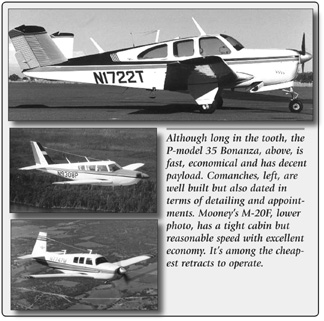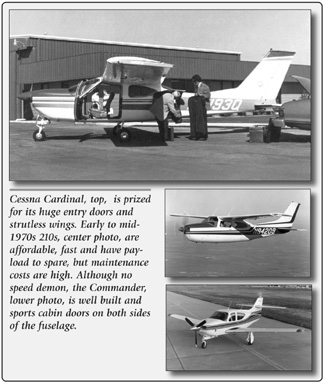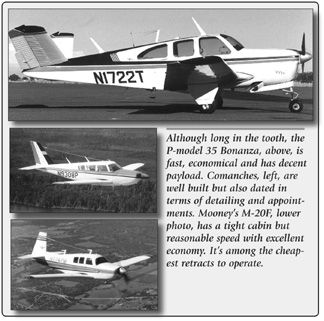
Under the old rules of aircraft design, to go fast, you tucked the wheels into the belly and hung a largish engine on the front of the airplane. To a degree, Cirrus, Lancair and Diamond have rewritten that equation by building slick airframes with fixed gear that doesnt need to be retracted to allow respectable cruise speeds. Thats a plus, of course, because fixed gear is more reliable and cheaper to maintain.
But only a fraction of would-be owners of fast cruisers can afford a new Cirrus or Lancair and even some who can choose not to tie up the better part of a half-million bucks in an airplane. For those buyers, a modest used retractable remains a top-value choice and the good news is the retractable market has been soft since the 9/11 price meltdown and there are good buys among several models.
For this article, were considering the budget end of the used retractable market, which we consider to be airframes in the $70,000 or less range. That means if you had your eye on a early 1980s Bonanza-an airframe thats a quarter century old, mind you-were out of your league in this report. we’ll look at high-priced cruisers in a future article.
What constitutes top value in this market? Since there’s no average buyer to poll on this question, were setting our own criteria: top value is the most speed for the least purchase dollar. The two other variables that impinge on value are useful load and operating costs. All the speed in the world is no fun if the thing burns so much gas you cant afford to fly it or if it takes two hours of wrenching for every hour of flight. Similarly, if the airplane wont carry what needs carrying, its no bargain. Youre better off spending more to meet your payload needs.
For our purposes, were looking for modest retracs that have taken a price hit in recent years but are still selling near or below the $70,000 target price. In order to weight our considerations with speed in mind, we used a speed-biased evaluation method were calling the efficiency or E-factor.This gets to the core of operating costs since its really a measure of fuel economy. Our formula is simple: speed squared divided by fuel consumption.
There are lots of airplanes to pick from in this class, which were defining as four-places, even though later Cessna 210s can have two extra seats. Our choices include the Piper Arrow, no later than 1976; Mooney M20 series, no later than 1976; Cessna 172RG, no later than 1981, Cessna 210s (circa 1967 and earlier) and the Beech 35 series, early-1960s vintage. Also from Beech is the C24 Sierra, essentially any year, since even the most recent model, the 1983, sells for under $70,000 and from Piper, the Comanche series. Commander 112As are also on the shopping list.
Price Scan
Do buyers shop strictly on price, strictly on a year-model threshold or strictly on speed and payload? Answer: all of the above. Every buyer brings a different set of variables to the process. For those who shop on price alone, our market scan of recent trends reveals that during the past five years, some of the models were examining have appreciated in value, some have declined while others have held their own. Thats unusual; usually, for any given period, aircraft show a steady rise in value. Clearly, the 9/11 malaise lingers.
Reviewing Aircraft Bluebook Price Digest data between 1996 and 2004, the Piper Arrow, pre-201 Mooneys and Comanche 250 appear to be the big winners; all of them appreciated 10 percent or more during that period. The Beech models and Cessna 210G, on the other hand, have declined slightly, suggesting some over valuation in the market. In between is everything else on the list. The Commander 112A appreciated by a healthy 16 percent but were sure this is based on limited data due to the airplanes relatively low population.
What all this means is that if youre out sniffing for a bargain and price is the main driver, early-1960s Bonanza V-tails-specifically the P and N models-appear to be good buys and there may be more dickering room in the asking price then there was five years ago. Although the P and N models are a lot of airplane for the money, we believe some owners may not wish to own something that was new when John Kennedy was in the White House.
If a bargain price is a must but speed isn’t, the Bonanza trails this pack while the Piper 250 Comanche and Arrow represent compromises in both asking price and speed. The Cessna Cardinal is in this category, too. The Comanche will cruise at a respectable 150 to 155 knots while the Cardinal will do about 145 knots. Yet the Cardinal will be a full decade younger than either the Comanche or the Bonanza and $70,000 will buy a nice one with money left over for an avionics upgrade. The pre-201 Mooneys-the C-model and F-model, mid-1970s-are in the same price and speed class.
Raw Speed, Efficiency
In this analysis, the Bonanza and Cessna 210 win, with the Comanche 250 hanging in near the top of the scale. Everything else sucks wind by at least 5 knots and as much as 30 knots near the bottom of the list. Mooneys are vaunted for their speed but the normally aspirated models are more efficient than fast-more on that in a moment-and the Arrow, the lower-powered Comanches, the Cessna 172RG and 177RG and the Commander are what we would call leisurely cruisers. That means they arent stopped dead in a winter headwind but don’t plan on arriving early, either. If all-out speed is important in a step-up retract, the Bonanza and 210 are the winners.
Now that the age of $4 avgas has arrived, some owners are finding smaller engines and more efficient airplanes to be attractive. And thats where the Mooney shines. The winner of our E-factor efficiency study is the Mooney F-model, which ekes 150 knots or more out of a 200-HP Lycoming. Interestingly, the Beechcraft don’t do badly in the efficiency sweepstakes for although they have large displacement engines, those powerplants are relatively efficient and the Bos fast cruise speed gives it a leg up. Of course, you’ll still spend more to feed it and the extra dollars probably wont be offset by the time saved on typical flights.
The slugs are the Commander, the dowdy Beech Sierra and the 250 Comanche. Unfortunately, despite having other attributes, the Sierra and Commander are relatively slow and inefficient airplanes.
Payload
Next to speed, another yardstick for many owners is payload. For our ranking, we count payload as how much the airplane will carry with the tanks full.Here, no surprise, the Cessna 210 wins but-surprise-the Bonanza is right behind it. While the Cessna 210 deserves as its reputation as a prodigious hauler of people and stuff, it didnt really earn that reputation until its gross weight pushed 3800 pounds and that didnt happen until the M and N models appeared. (Late model 210s have gross weights of as much as 4100 pounds.)
Both the Cessna 210 and the Bo of the vintage were considering here will carry more than 700 pounds with the tanks full. Thats 80 gallons in the Bonanza, 90 gallons in the Cessna. The Bo is somewhat hobbled by an aft-tending CG but if you stuff your stuff into a Cessna 210 and close the doors, the CG is likely to be within limits.
As far as payload goes, everything else in this class of airplanes carries at least 100 pounds less than the 210 with full fuel. The Commander, the Cessna 172RG and Piper 180 Comanche pull up the rear in load carrying capability. The Mooneys finish more or less in the middle of the group, carrying about 700 pounds or a bit less with the tanks full.
Practical payload is the ability to carry even more and still have enough gas to fly a reasonable trip. Again, the Cessna 210 and Bonanza are the top performers in this regard. With 90 gallons of gas, the 210 can be fueled with, say, 60 gallons and still have four hours of endurance with reserves.Thus fueled, it will carry a half ton in the cabin.
Comfort, Handling
In airplanes, as in cars, comfort equates to space so larger cabins tend to be more comfortable, seat design notwithstanding. Again, the Bonanza and the Cessna 210 sport the largest cabins but the Commander 112 has a curious advantage here: it has two entry doors so ingress and egress are more civilized than in the Bonanza, with its single door. The 210 also two doors but the step-up in the cabin can be awkward. Here, the Cardinal shines. Its lower slung and has enormous doors to ease entry and exit into both front and rear seats.
Surprisingly, the Bonanza cabin width at the shoulders is within an inch of the Mooneys width but in the Mooney, the cabin section tapers more and the seats are much lower, making getting into and out of the airplane a chore compared to the Beechcraft. Also, the seats are less comfortable in the Mooney, in our estimation and the backseats are shoehorn tight, especially the C and E models, which have the shorter cabins than the F.
The other airplanes in this class, the Arrow, the Comanches and Cessna 172RG have what we consider to be average comfort levels; nothing horrible but nothing special, either. The Cessnas tend toward drafty cabins-Cardinals tend to leak rain in flight-while all of the low-wing airplanes can be solar broilers in the summer. (The Commanders two doors help here, too, since they can be propped open for ventilation.
In handling and flyability, there’s the Bonanza and there’s everything else. Even old Bos seem to handle more nicely than newer airplanes. Stepping from, say, the Cessna 210 or Arrow into a Bonanza, most pilots will be shocked at how much better the V-tails controls are harmonized. In comparison, the 210 is stiff and trucklike, the Arrow workmanlike, with no ugly surprises.
Were often told that Mooneys handle like sports cars, an observation we agree with if the car happens to be a mid-1950s Austin Healey. Because of their control circuitry design, Mooneys tend to be stiff in roll, although pitch forces are not unusual. In pure yank-and-bank ease, the Bonanza is superior, in our view. The payback is that in turbulence, the Bonanza wags its tail like a Labrador at dinner time. A little pressure on the rudder pedals reduces tail wagging but owners still complain about it.
Were also told that Bonanzas are supposed to be easy to grease onto the runway. And while we do find them easy to land, some of the other models-including the Mooney-will slide onto the payment just as smoothly as the Bonanza will, despite the latters vaunted gear design. The Bos gear legs do a better job of soaking up bumps than do the Mooneys rubber donuts, however.The Cessnas also tend to be stiff legged on the runway.
Of all these airplanes, the Mooney is least tolerant of being stuffed onto the runway before its done flying; it will bite back by porpoising. The Beech Sierra has the same nasty habit, probably because, like the Mooney, it has rubber donuts for shock absorption rather than oleos. Although slow in cruise, the Sierra doesnt like to get too slow or too fast on final and thus is surprisingly demanding to land.
The lighter Cessnas-Cardinal and Skyhawk-land like Cessnas. Once the gear is down, most pilots would be hard pressed to distinguish between the fixed gear and retractable version. The Cardinal is more sensitive in pitch and more susceptible to PIOs than the other models while the 210 comes down final on rails and needs some manhandling in the flare.
Owners report mixed results in landing the Comanche series. Some say its notoriously difficult to land without a sharp payoff just at touchdown, others say this is nonsense; the airplane is a joy to fly and land.
Systems, Maintenance
In a normally-aspirated retractable, the gear system often dominates maintenance and here the models diverge in performance and results. Cutting straight to the chase, the Bonanza and Mooney have the best gear systems, all but bulletproof electro-mechanical designs with manual reversion. Many of the pre-201 Mooneys have excellent if somewhat awkward-to-use manual gear systems; a manly Johnson bar sticking up through the floor.

Next best are the electro-hydraulic designs used in the Commander and the Pipers. While these are more complex and less reliable than electro-mechanical designs, they have proven to be only moderately maintenance intensive in the field. In older airplanes with hydraulics, hoses tend to degrade and leak, pump seals go bad and cylinders need replacement.
And that brings us to Cessnas electro-hydraulic designs which are, by far, the worst in our view. The systems are complex and needy of tweaks, adjustments and parts replacements. While some Cessna enthusiasts insist that Cessnas gear systems arent as bad as all that, the fact is that Bonanza and Mooney systems go for years without significant maintenance. Try that with a 177RG or a 210 and you’ll be asking for trouble.
Otherwise, maintenance on these older airplanes is often age related. One Comanche owner wrote us to say: A Comanche is sort of like a helicopter. You can afford to buy it, but the cost of keeping it is out of proportion when compared to other four-cylinder…airplanes. The same advice may apply to any of the airframes older than 35 or 40 years. As airplanes age, they require more maintenance and some don’t get it.
Bonanzas continue to be highly serviceable airplanes that don’t tend to break much. But when they do, parts can be ruinously expensive, including Continental engine components such as starters and alternators. Buy a we’ll maintained example and keep it that way, and a Bonanza is not unreasonable to own. Stumble into a basket case and you might have been better off buying an airframe costing twice as much.
Cessna 210s have a mixed reputation for maintenance appetite but nearly everyone agrees, the gear needs frequent attention. One owner joked that to own a mature Cessna retractable, you need to be married to an A&P. While we think thats a bit harsh, there’s truth to it and it applies to Cardinals and retractable Skyhawks, too.
If there’s anything approaching maintenance nirvana here, we would put Pipers Arrow, the Mooneys and perhaps the Commander in that category. All three have decent, low-maintenance gear systems and all three normally aspirated versions have Lycoming engines, whose accessories tend to be cheaper than those from Continental. Piper and Mooney parts are easily available and moderately priced and neither brand has characteristically expensive maintenance bugaboos.
Based on reader reports, we would rate maintenance intensity on the airplanes from best to worst in this order: Piper Arrow, Mooney M-20s, Bonanza, Commander, Cessna 172/177, Piper Comanches and the Cessna 210.
Conclusion
Why buy a retractable? There are only two reasons we can think of: the first is to go faster, the second to build time to get into something of higher performance. If speed isn’t a driver, it makes no sense to buy a retrac just so you can say positive rate, gear up. The grim other side of that coin is that every landing represents an opportunity to say, oh X#$%!, I forgot the gear.
Is there is a best value airplane hiding in this group, one than stands out among all the others? If a buyer brings no inflexible criteria to the decision, in other words, a budget is set but the would-be owner has no firm opinions on needing anything other that a faster airplane with folding wheels, we think the Bonanza is a standout value here. The P-models haul a lot, go fast and have plenty of range and payload flexibility.
But there’s a problem. Our proposed $70,000 budget buys an early 1960s Bo. Do you really want to tie that much money up in a 40-year-old airframe?We have misgivings about that, although we know plenty of owners don’t and happily drive older Bonanzas, singing the praises of fast cruise speeds and low purchase price.
Looking for something a full decade newer, we see another standout: the Mooney M-20 F model. Mid-1970s models can be had for about $70,000 and they have decent speed, payload and range. They have solid gear systems and arent especially expensive to operate or maintain. And unlike a Bonanza, a basket case can be brought back to life without seeking a second mortgage.
If hauling a growing family on a budget is your reason for wanting a retrac, the Cessna 210 is the standout. But it will come at the expense of higher fuel burn and maintenance costs and you’ll need to resign yourself to deal with that pesky gear.
Also With This Article
“Price, Cruise Speed, and Payload Compared”
“Money Scale”





